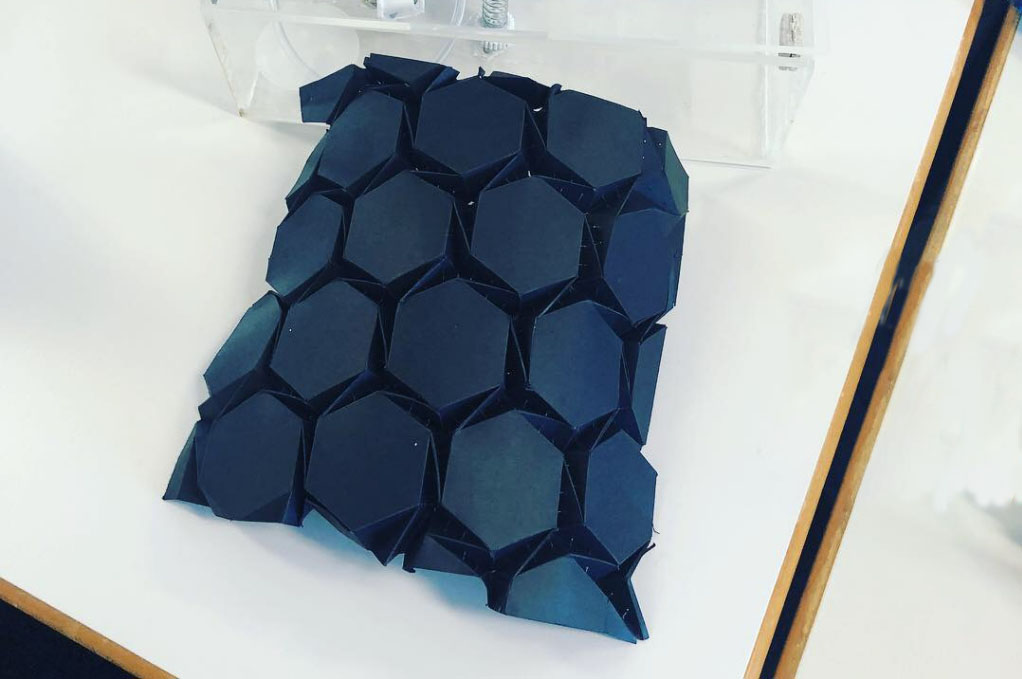Robotics meets architecture in the room that changes shape just for you
Rooms that learn human behaviour and change shape in response are the vision of UNSW Built Environment and the engineering firm behind the Sydney Opera House.
Rooms that learn human behaviour and change shape in response are the vision of UNSW Built Environment and the engineering firm behind the Sydney Opera House.

A unique origami-style meeting room that can respond to the behaviour of people has been designed by Bachelor of Computational Design students at UNSW Built Environment in a successful collaboration with top engineering firm Arup.
Once it’s completed next year, the interactive Centaur Pod will adapt to external environmental and human stimuli by moving up and down and changing its shape, according to UNSW’s Discipline Director of Computational Design, Associate Professor Hank Haeusler.
“At the moment, a human can be in the same space as a robot and can interact in the space with the robot, but what we want to do is make space itself become the robot,” the Associate Professor said.
“Thus when a person in a building moves, behaves or operates in any way, the ‘robot’ will sense this behaviour and starts learning from this behaviour and other people’s behaviour and will create knowledge from the behaviour and the knowledge will translate into the space to change.
“And I think that’s very, very unique and I don’t know of any firms or architecture at university that are looking at combining machine learning and kinetic architecture in the same way as we do.”
Associate Professor Haeusler said the biomimicry influenced kinetic pavilion is an exploration of interactive architecture and soft robotics.
“It’s quite interesting that students studying in an architecture and design faculty are exploring robotic structures, without being robot engineers,” he said.
The Computational Design students are designing, developing, documenting and fabricating the prototype with Arup, the engineering firm behind the Sydney Opera House, over three-semesters.
The real-world research project explores three main areas that Associate Professor Haeusler said will profoundly change the way architects design, develop and manufacture in the future: machine learning and artificial intelligence; digital fabrication and robot fabrication; and augmented reality and virtual reality.
“We try to push as much as possible the boundaries of conventional architecture and design, and explore what machine learning, biomimicry or creative robotics have to offer for spatial design to use this knowledge as a seed to develop architectural design projects,” Associate Professor Haeusler said.
“We’re looking at how digital fabrication and robot fabrication could shape the way we build buildings or structures.
“The Centaur Pod pavilion becomes a case study or an experimental field where we can test all of those ideas, through students, through academics, through Arup as an industry partner, and then we develop, evaluate, and discuss the outcomes and bring them into practice.”
He said the approximately six- to nine-square-metre pavilion will be constructed next year and will be showcased first in Arup’s Sydney office to travel then to the Melbourne and Brisbane Arup offices, and potentially internationally to office locations such as New York, Hong Kong, London or Beijing.
The Associate Professor said he’s confident that some of the ideas developed in the collaborative project will find their way into architectural design on real buildings.
“It’s a perfect kind of way of showcasing the quality of our Computational Design students because Arup are exposing our undergraduate student work to an international audience and show what they can do, and I think that’s very, very exciting,” he said.
Ms Sinickas said the partnership with UNSW Built Environment has been valuable to the company.
“We really like the partnerships where we share our expertise with the students, and are exposed to their energy and excitement. We are inspired by these young students who see things very differently. It furthers our profession and our skills,” Ms Sinickas said.
“It’s a very exciting time to be in engineering and design.”
The Bachelor of Computational Design combines architecture and design, and computer science and engineering to the way design content is imagined, created, fabricated, delivered and displayed. Find out more about the course here.